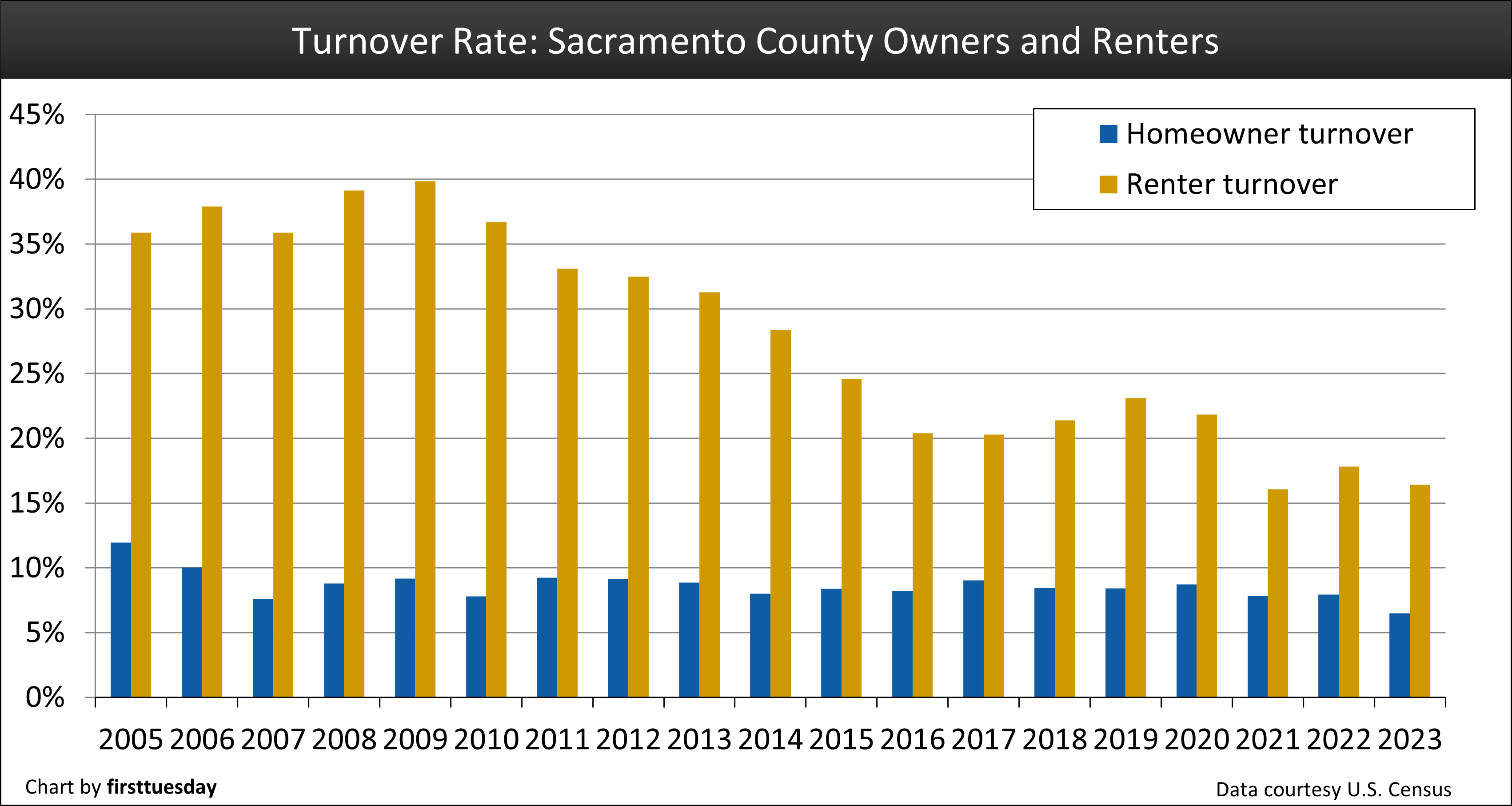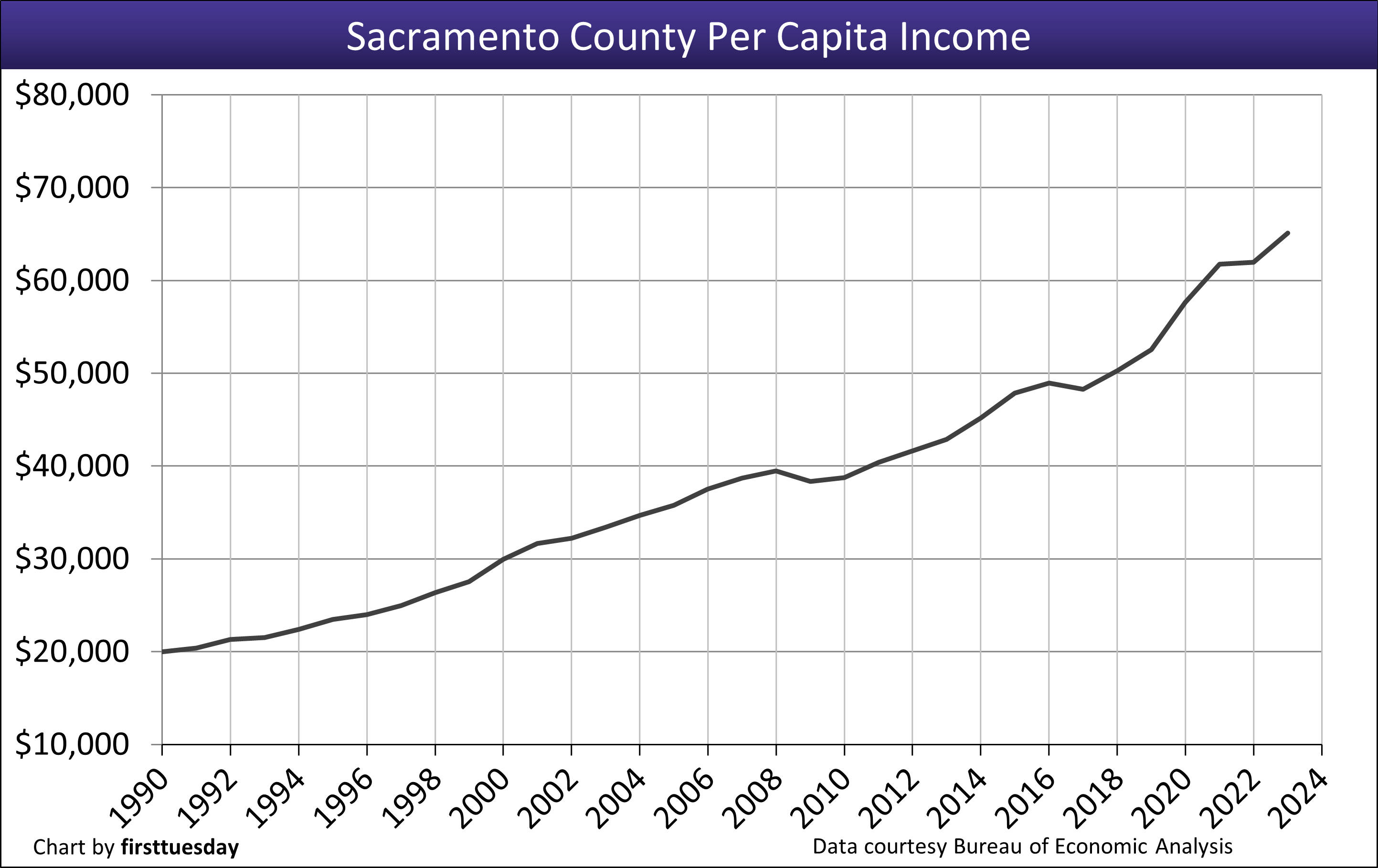Why this matters: Available local data informs brokers and agents looking to better serve their clients and represent themselves as experts in their community.
Slow to rise or fall
Sacramento County, encompassing California’s capital and cities like Elk Grove, Citrus Heights and Folsom, is home to the California Department of Real Estate (DRE). This region was one of the last counties in California to reach a jobs recovery from the 2008 recession, necessary to fuel wallets and in turn household formations. Its lagging recovery can be attributed partially to Sacramento’s dependence on state and local government jobs, which were slow to return.
This recovery was quickly followed by the 2020 recession, resulting in significant job losses and a complete erasure of the prior five years of job gains. But unlike the 2013 recovery, jobs in this region returned more quickly than other parts of the state, likely due to its reliance on government funding, which was abundant during the pullout from the 2020 recession.
By mid-2022, home sales volume had dropped and prices began to fall back, due to buyer resistance brought on by rising interest rates and ending the pandemic monetary and fiscal stimulation. Also, the abrupt return of higher interest rates slashed buyer purchasing power which cooled both buyer and seller attitudes about acquiring and disposing of property.
In the aftermath, ownership turnover declined, further strangling MLS inventories of property for rent or for sale, and accelerating property price increases to ever-greater, unsustainable heights. But buyer reluctance outweighed seller reluctance, which drove up inventory going into 2025.
In 2025, Sacramento County will see sales volume and prices decline from uncertainty about the future worsened by 2025’s deteriorating economic situation and instability of federal governance.
California’s real estate recession underway since mid-2022 has no present signs of relief. Look for prices to bottom around 2028 with adverse pricing pressure on all types of property due to a rise in the cost of mortgage funds and the level of capitalization rates.
Thus, real estate agents are faced with the need to consider how to recession-proof their careers. So, get to know Sacramento’s local housing fundamentals in the charts that follow.
Updated June 6, 2025.
Home sales volume decline bounced in 2024

Chart update 6/6/25
| 2024 | 2023 | 2022 | |
| Sacramento County home sales volume | 12,600 | 11,700 | 15,700 |
Sacramento County home sales volume has avoided much of the volatility of California’s other major metros. After years of essentially flat sales volume, home sales volume in 2024 totaled 7.5% higher than a year earlier. Other California major metros experienced far less growth in sales volume during the 2024 bounce, with the sales volume increasing 5.5% statewide.
However, compared to the last “normal” year for home sales, 2024’s home sales volume total was 35% below 2019. Thus far in 2025, sales volume year-to-date is buoyant at 3.4% above a year earlier, but is 32% below 2019 and the 2025 trend has turned downward.
Home sales volume in Sacramento has not been as volatile as many other parts of the state. One reason is the consistent addition to the for-sale inventory in the form of residential construction. In California’s extensive and desirable coastal cities, new construction has been held back significantly by no-growth zoning ordinances and inward looking not-in-my-backyard (NIMBY) advocates and their city councils. Not so in Sacramento, where construction and new neighbors are welcome which collectively allows sales volume to keep pace with homebuyer demand relative to other regions.
Even so, home sales are expected to continue their slowdown heading into 2026, primarily due to higher interest rates, the loss of homebuyer enthusiasm to own, and the sudden destabilization of both immigration and trade. Currently, builders are harnessed in by newly-imposed trade taxes on materials and an intimidation of the needed migratory labor force.
With buyer confusion about to precipitate a steep drop in property sales and prices, expect a decline in job availability heading into 2026 to further affect pricing. Sales volume will not stabilize until the market has worked through the past five-year double-dip recession in real estate and jobs begin a consistent return.
Related article:
Inventory rises from historic lows

Chart update 6/6/25
| April 2025 | April 2024 | Annual change | |
| Sacramento County for-sale inventory | 6,200 | 4,700 | +33% |
Multiple listing service (MLS) inventory has risen from the historic lows reached at the end of 2021 and 2023. After two years of steep inventory declines followed by a brief bump in 2022, for-sale inventory in Sacramento as of April 2025 averaged a significant 33% above a year earlier.
However, the recent trend in inventory growth is not due to excess buyer demand. Rather, today’s lower inventory is the result of both seller reluctance to sell property of any type and buyer unwillingness to buy. Both sellers and buyers are pushed back by current high mortgage rates and this year’s relentlessly uncertain economic situation.
The significant interest rate increases of 2022 slashed buyer purchasing power, making it nigh on impossible for mortgage-financed homebuyers to acquire the price level of amenities they had come to expect. Looking forward, expect for-sale inventory to rise in 2025, possibly a lot higher. As for-sale inventories grow the average length of time on the market is extended. Sellers who need to sell are then forced to reduce pricing to attract mortgage-funded homebuyers.
The seller’s market of the past decade slid into a buyer’s market in 2022. Prices slipped significantly until early 2023 when inventory tightened to force buyers to pay more.
Today, homebuyers increasingly take a wait-and-see approach to buying as they become more aware of the market conditions of rising inventory and mortgage rates indicating future price reductions. The present global disruption in commerce has everyone’s attention with the ripple effect in consumer pricing on its way.
As a result, buyers in 2025 and likely 2026 are increasingly more attentive to real estate market conditions, more financially cautious and less willing to buy without significant reduction in seller pricing. Without government subsidies like in 2020, or a damaging national recession like in 2008, mortgage rates have little room to drop.
Homeownership revived primarily by residential construction

Chart update 6/6/25
| Q1 2025 | Q4 2024 | Q1 2024 | |
| Sacramento County homeownership | 68.7% | 59.3% | 65.5% |
The homeownership rate in Sacramento County varies greatly each quarter, though the general trend was flat-to-down over the past decade — until homeownership began to jump dramatically from quarter-to-quarter in 2017. As of Q1 2025, the homeownership rate is a high 68.7% in Sacramento. For comparison, the statewide average was a much lower 55%.
In 2022, Sacramento smashed past its homeownership record of 67%, previously set in 2005. Following the conclusion of the housing bubble when homeownership was last at its peak, many homeowners lost their homes to foreclosure. This is pictured in the swift decline in Sacramento County’s homeownership rate experienced in 2010, bottoming at 57% in 2011.
Meanwhile, the rest of the state has yet to catch up to the Millennium Boom levels of homeownership, and are unlikely to get there for several years, if at all. Statewide, the lack of property for sale — both resale and new construction — has pushed first-time homebuyers and turnover homeowners out of the market. Many households, persuaded by convenience and cost, keep renting their home instead of owning it. The cost of ownership at high purchase prices and high mortgage rates far exceeds rental rates for the same property.
Sacramento’s high homeownership rate is the result of relatively sufficient residential construction to keep up with demand. Compared with California’s other major metros, Sacramento’s looser zoning restrictions enable construction to meet the demand of homebuyer occupants of all income levels.
Still, expect Sacramento’s homeownership rate in the next few years to fall back as negative federal economic conditions ripple through California and initially discourage homebuyers. But that too will change.
As for-sale inventory rises and sales volume slips, prices soon drop and the equity in property declines, with many going negative. While in the next recession mortgage rates will decline a little and incomes for the employed rise at less than the rate of consumer inflation, resale prices of property will drop significantly to eliminate the blockage in property sales.
At some point moving forward, property sales volume will increase, likely around 2028, but that may happen in 2027 for all the chaotic financial distortions in the economy. Then, homeownership will rise again.
Turnover staying down

Chart update 6/6/25
| 2023 | 2022 | 2021 | |
| Sacramento County homeowner turnover rate | 6.5% | 8.0% | 7.8% |
Sacramento County renter turnover rate | 16.4% | 17.8% | 16.1% |
A real estate agent’s living is contingent on residential turnover. Without turnover, property is not available for sale, tenants stay put and mortgage originations go nowhere.
Owner-occupant turnover — the percentage of homeowners who moved within the last 12 months — remained steady at around 8% each year since mid-2010 but took a dramatic decrease to 6.5% in 2023. An 18% drop in homeowners as available buyers since 2022.
The general trend for renter turnover is also down. Renter turnover peaked in 2009 at a massive 40%. For perspective, that means two out of five renters moved in 2009 — a significant sum for California. A lot of tenant turnover was due to a flood of homeowners selling (often by short sale or foreclosure).
The post-Great Recession buyers were tenants becoming owners or investors renting to relocating tenants and foreclosed-out owners who preferred renting an SFR. Renter turnover has fallen each year since rebounding slightly in 2017-2019 but fell back significantly to 16.4% in 2023.
Turnover was held down in 2020-2021 as a result of moratoriums on evictions and foreclosures. Looking at the ongoing 2022 real estate recession, expect the frequency of turnover to increase, but not because they are buying or renting another property. When job growth declines and wages stagnate, residents often lack the financial ability to rent or buy elsewhere.
Also, moratorium mortgage modifications are now resetting to force owners into selling. Those who cannot afford their present housing then tend to consolidate with others to share housing and the costs.
After a recession, the turnover rate ticks upward as employment begins a consistent recovery and wages improve sufficiently, likely sometime after 2028. The steady increase in jobs and wages boost confidence in the future of the economy and gradually reduce fears of carrying mortgage debt – but not until after prices complete their downward adjustment, a déjà vu event.
Residential construction slowly rising

Chart update 6/6/25
| 2024 | 2023 | 2022 | |
| Sacramento County single family residential (SFR) starts | 4,900 | 3,400 | 3,700 |
Sacramento County multi-family starts | 1,800 | 2,900 | 1,800 |
After years of flat performance, construction in Sacramento County began to make solid gains in the pandemic period of 2020-2021, only to fall back in 2022.
In the past couple of years, builders in several different months started zero new multi-family or single family residential (SFR) construction projects. This dormant situation followed the injection of new growth in the pandemic period. Investors set their eyes on Sacramento as a city primed for residential growth. It has since fallen back, tempered by the cost of building materials and uncertain occupancy by tenants or buyers, which characterizes construction across the state.
However, even 2024’s level of construction was below what Sacramento needed to keep up with demand from homebuyers and renters alike. In fact, the peak year of 2003 saw nearly two times more SFR construction starts than the 4,900 SFR starts experienced in 2024. But multi-family construction declined in 2024, falling back 38% from the prior year.
Sacramento construction is likely to be shielded from increasing negative effects felt throughout other California metro areas. State legislative efforts to increase the low- and mid-tier housing stock have focused on encouraging more multi-family construction. With Sacramento’s relatively low cost of living compared to other Central and Northern California metros, it has become an attractive area for many first-time homebuyers and renters looking to save and still maintain a high standard of living.
Even then, SFR construction starts are not likely to return to the level permitted by deregulated predatory mortgage-driven numbers experienced during the hyperactive Millennium Boom. That said, the federal government is again deregulating banking – mortgage lending – and killing off consumer protection agencies which police lenders while de-criminalizing bank behavior. These national steps will bring back some of the “wild west” lending of the 2000’s for Californians to experience in the second half of the 2020s.
The next peak in SFR construction is likely to occur post-2026-2027 once the uncertainty and chaos currently driven by government trade wars increasing material costs and immigration disruptions of the labor force greatly subside.
The jobs recovery reversal after the 2020 recession

Chart update 6/6/25
| May 2023 | May 2022 | Annual change | |
| Sacramento County jobs | 1,096,900 | 1,093,900 | +0.3% |
Sacramento was one of the last counties in California to reach a pre-2008 recession jobs recovery. Its lagging recovery can be attributed partially to Sacramento’s dependence on state and local government jobs, which were slow to return. On the other hand, the region’s recovery from the 2020 recession occurred much more quickly, with government-funded jobs in all public and private sectors minimizing losses. As of May 2023, jobs fully surpassed the pre-2020 recession peak.
But the rising jobs momentum disappeared by April 2025, with 0.3% more jobs than a year earlier and, critically, now trending down. The current declining trend began when the undeclared real estate recession set in mid-2022. It will end when the intervening trade wars are behind us and property prices have significantly corrected to eliminate the pandemic asset inflation fueled solely by historically cheap mortgage money.
Real estate jobs lacking

Chart update 6/6/25
| April 2025 | April 2024 | Annual change | |
Construction | 75,700 | 75,600 | +0.1% |
Real Estate Rentals & Leasing | 17,200 | 17,800 | -3.4% |
The recovery after 2008 in jobs lost by those in the real estate and construction industries has been slow. Both peaked in 2023 and are now in a declining trend.
Keep in mind that while the chart above shows an overall rise in both real estate and construction jobs, the actual number of construction jobs displayed is seven times that of real estate jobs on the chart (the chart is displayed in this manner to make the change in real estate jobs perceptible).
Also, consider that the pandemic economy artificially drove up employment for both categories due exclusively to government fiscal and monetary stimulus. Cash was injected into the entire economy to rapidly and fully offset the devastating effect the pandemic had on jobs.
Some real estate jobs will be cast off in 2025 as sales volume, followed by pricing, trends downward. However, expect construction jobs to be regained more swiftly as more housing is needed to meet housing demand and legislated mandates for starts.
Income on the rise

Chart update 6/6/25
| 2023 | 2022 | Annual change | |
| Sacramento County per capita income | $65,100 | $62,000 | +5.1% |
| California per capita income | $81,300 | $76,900 | +5.6% |
Sacramento County surpassed its 2008 (pre-recession) peak of $39,671 in per capita income just three years after the recession in 2011. In contrast, most of the state didn’t catch up with pre-recession income until 2012.
However, Sacramento County’s average income in 2023 remained well below the state average, a familiar income level for the region. Government employee compensation is less than state averages but more long-term in duration than the private employment turnover throughout the state.
Income sets the price of homes and rental units — buyers and tenants only pay as much for housing as their wages and salaries qualify them to pay – around 1/3rd of their gross household income. In contrast, annual home price movement during a business cycle is controlled and responds to investment demand, not consumer demand. Rent paid to use a property is a consumer demand subject to personal income; the price paid to own is a capital asset subject to money market conditions.
Property prices often rise or fall dramatically from year to year with no relevance to the annual rate of consumer inflation and wage increases. Property prices always return to a historical mean price trendline; wages paid rarely drop for those who remain employed during a recession. In any given year, home pricing and buyer purchasing power to acquire ownership are controlled by factors such as:
- mortgage rates;
- wages and salaries from jobs;
- personal savings;
- housing starts;
- available inventory for rent or sale; and
- individual confidence in the immediate future.
Expect to see average income rise to halt and fall back a little in 2026-2027, the result of job losses but not a reduction in an employed individual’s wages. With the fog of international trade chaos, expect to see job losses translating into forced home sales when job-less owners seek to avoid foreclosure.
Also, the consistent increase in for-sale inventory will depress prices. Collectively, the influence of these factors on local demographics sets the basis during the next recovery for renters and homebuyers to be able to, well, rent and buy real estate.















Growing bananas in Sacramento County—how cool is that? With our mild winters and plenty of sunny days, it seems like the perfect environment to give tropical fruits a try. Does anyone here have experience growing bananas locally, and are there any specific challenges to be aware of? I’d love to see more tips for keeping the plants healthy in our climate, especially during cooler months. Could this mean we’ll see more tropical fruit at our farmers’ markets soon? It’d be amazing to support local banana growers and have fresh bananas right from our own community!
It’s no secret that the housing market in Sacramento has been fluctuating like crazy! These housing indicators definitely show how challenging it’s becoming for both buyers and renters. I’ve noticed so many people moving out of Sacramento recently due to affordability issues. Are we headed for a correction soon, or is this the new normal? I’d love to hear more about how locals are managing these high prices and if there are any realistic solutions in sight. Affordable housing feels more urgent than ever around here.
It is fun reading the comments from 2018. If those people would have bought in 208 they would be very happy today.
Sacramento real estate prices don’t look like they will decrease anytime soon. Surprising to see this market continue to climb.
I would lke to know who is getting the raises, Sacramento is still 20 years behind for the same job in the rest of California. I can’t imagine prices going beyond 350k before we have anouther burst and anouther cover up by the banks setting their own values on Auction homes that are a result of stagnent wages and higher prices for everything form one of the highest tax base in the country to the cost of new shackeled needs like smart phones and old ones like food getting out of controll. You can only split a 20 year old wage so many ways.
The people getting raises can spell, and use correct grammar (try grammarly.com before you post next time). I have been looking at relocating to Sacramento. There are lots of jobs, and the wages for my office job are almost the same, but the home prices are much lower in Sacramento.
They are allready getting soft, anything over 325,000 in East Sac is just sitting there. Buyers are not buying the old and beaten up for top dollar with new homes competing at the same price point. Not as many will pay top dolllar for a house with a worn out roof and pool with outdated fixtures anymore when they can buy new. Some of the younger Agents have never seen what the real market looks like with all the artificial market tampering from the big banks casting a wide net over all the forclosures that sit empty or have renters and homeless either babysitting or squatting. Have walked into a few potty boxes in the past few months without warning and seen beautiful homes distroyed by those who are suposed to be taking care of the property but are running off buyers so they don’t get thrown out. And there is the over developed and the “it a sellers market” attitude, not anymore. Buyers are still complaining from the last crash and cost of living along with property taxes have risen faster than wages allready low for California. LA is starting to crash and the Bay Area is the next place expected to start to fall.
If you look at all the price reductions you will get it. Just follow the bouncing heart on the web and watch everything over 350k sit if it has repairs needed.
Sellers got too used to getting away with leaky roofs and dry-rot but if you add it to the asking price it simply dose not make sence to pay 30 k in repairs when you can buy new.
I feel like rents in the area (I’m in Folsom) have skyrocketed in the past three years. One house I almost rented in 2015 recently rented for $1650 with no change to the condition of the home. A friend of mine just had his rent increased at a popular apartment complex in Folsom to $1575 for a one bedroom. I am totally against rent control so please don’t go there, but I don’t think local incomes support these increases (or at least not their continuing increase.)
If you do a search on Zillow for houses in Sacramento County, look at all of the blue dots on the map. These are foreclosures, or pre-foreclosures (uncheck the box marked “make me move.”) There is a lot of blue on the map!
What are your thoughts?
You’re not very wise to be paying an excess of $1,500/month to rent a home in Folsom. It would probably make sense to step down so that you can come up. There are plenty of nice homes in Sacramento where you could afford a home; build some equity and move on. Folsom has nothing to offer but chain restaurants and suburban dullness. Plenty of 20 somethings living in cottage style homes in older neighborhoods throughout Sacramento proper (Not Rancho Cordova or Citrus Heights).